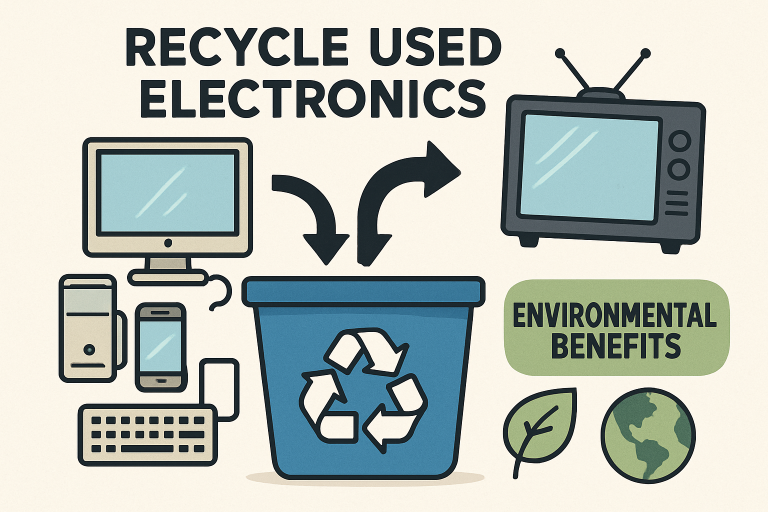Electronic devices have become indispensable in daily life, but their rapid turnover has created a growing environmental challenge. E-scrap—or electronic waste—contains valuable materials alongside hazardous substances that can harm ecosystems if disposed of improperly. Responsible recycling prevents pollution, recovers precious resources, reduces landfill use, and supports a circular economy. By understanding and embracing proper e-scrap recycling practices, individuals and businesses can contribute to a greener, more sustainable future while protecting the environment and human health.
What Is E-Scrap and Why Does It Matter?
E-scrap, also called electronic scrap or e-waste, refers to discarded electronics such as old computers, televisions, smartphones, and household devices. With the rapid pace of technological innovation and frequent device upgrades, the amount of electronic waste generated each year has soared. According to the United Nations Environment Programme, the world now creates over 50 million metric tons of e-waste annually, making responsible management critical for environmental and public health.
This waste contains hazardous substances like lead and mercury that can contaminate land and water and holds valuable resources that could be recovered and reused. For those seeking sustainable disposal options, working with reliable electronic scrap buyers near Houston ensures electronics are handled responsibly, reducing ecological impact and maximizing recovery of precious materials.
Environmental Benefits of E-Scrap Recycling
Recycling electronics diverts toxic chemicals from landfills and prevents them from polluting soil, air, and waterways. Many devices contain gold, silver, copper, and rare earth metals that can be recovered through specialized recycling processes—reducing the need for mining and conserving finite resources. According to the U.S. Environmental Protection Agency, recycling just one million laptops saves enough energy to power more than 3,600 average U.S. homes annually. These statistics highlight how impactful even small recycling efforts can be when adopted at scale.
Current Regulations and Industry Shifts
E-scrap recycling policies continue to evolve worldwide. In many countries, it is illegal to dispose of electronic waste in regular trash streams due to toxicity and long-term pollution risks. Legislative trends—including Extended Producer Responsibility (EPR) laws—require manufacturers to design products with recycling in mind and take greater responsibility for end-of-life collection. Reports from leading industry publications emphasize the rapid growth of EPR and the industry’s focus on accountability, transparency, and traceability throughout the e-scrap lifecycle.
Global Challenges and Innovative Solutions
While progress has been made, only about 17% of e-scrap is formally collected and recycled worldwide. Much of the rest ends up in landfills or is exported—often illegally—to countries lacking adequate environmental controls. This can result in hazardous exposure for vulnerable populations and environmental degradation. However, advanced recycling technologies such as automated material sorting and chemical recovery are emerging to increase efficiency and safety. International agreements aim to minimize the transboundary movement of hazardous e-waste, underscoring the importance of global cooperation.

Where Does E-Scrap Go After Collection?
Once collected, e-scrap enters a comprehensive processing chain. Items are first sorted and dismantled, separating out plastics, metals, and hazardous elements. Metals such as copper, gold, and aluminum are extracted using state-of-the-art recovery methods and fed back into the manufacturing cycle. Plastics may be recycled or converted for new uses, while harmful materials like lead or cadmium are isolated and safely disposed of. Some good-quality electronics are refurbished and resold, extending their useful life and reducing the pressure on raw resource extraction. This closed-loop approach helps promote a sustainable circular economy model.
Practical Tips for Households and Businesses
- Back up and secure all personal data on electronics before recycling. When possible, use software designed for complete data erasure.
- Identify and utilize certified recycling partners by checking local government resources or industry-recognized directories. Certification helps guarantee environmental and data security standards.
- If you represent a business, develop internal asset management plans that track each device from acquisition to final disposition and encourage responsible upgrades or repairs.
- Where possible, donate functional electronics to charities, schools, or community organizations to prolong their useful life before turning to recycling.
- Monitor announcements for local e-scrap collection events—offered by municipalities or environmental groups—especially during spring cleaning or Earth Day drives.
Mythbusting: Common E-Scrap Recycling Misconceptions
A prevalent misunderstanding is that simply deleting files protects sensitive data; physical destruction or certified data wiping are required to prevent data breaches. Another myth is that any recycler provides the same benefits—a fact disproven by investigations into improper disposal and illegal exporting. Consumers and businesses should carefully vet their recycling partners to ensure responsible, ethical handling. Finally, the surprisingly low global recycling rate for e-scrap is often underestimated, making education and accessible recycling options essential for improvement.


